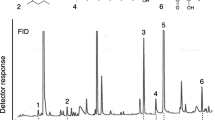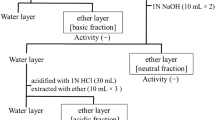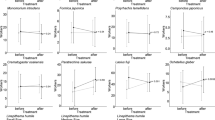Abstract
Four species of Tetramorium pavement ants are known to guide foraging activities of nestmates via trail pheromones secreted from the poison gland of worker ants, but the trail pheromone of T. immigrans is unknown. Our objectives were to (1) determine whether poison gland extract of T. immigrans workers induces trail-following behavior of nestmates, (2) identify the trail pheromone, and (3) test whether synthetic trail pheromone induces trail-following behavior of workers. In laboratory no-choice bioassays, ants followed poison-gland-extract trails farther than they followed whole-body-extract trails or solvent-control trails. Gas chromatographic-electroantennographic detection (GC-EAD) analyses of poison gland extract revealed a single candidate pheromone component (CPC) that elicited responses from worker ant antennae. The CPC mass spectrum indicated, and an authentic standard confirmed, that the CPC was methyl 2-methoxy-6-methylbenzoate (MMMB). In further laboratory no-choice bioassays, ants followed poison-gland-extract trails (tested at 1 ant equivalent) and synthetic MMMB trails (tested at 0.35 ant equivalents) equally far, indicating that MMMB is the single-component trail pheromone of T. immigrans. Moreover, in laboratory two-choice bioassays, ants followed MMMB trails ~ 21-times farther than solvent-control trails. In field settings, when T. immigrans colonies were offered a choice between two paper strips treated with a synthetic MMMB trail or a solvent-control trail, each leading to an apple bait, the MMMB trails efficiently recruited nestmates to baits.





Similar content being viewed by others
Data Availability
All data are presented in the main body of the manuscript.
Code Availability
Not applicable.
References
Attygalle AB, Morgan ED (1983) Identification of trail pheromone of the ant Tetramorium caespitum L. (Hymenoptera: Myrmicinae). Naturwissenschaften 70:364–365. https://doi.org/10.1007/BF00990315
Baur B, Storch K, Martz KE, Goettert MI, Richters A, Rauh D, Laufer SA (2013) Metabolically stable dibenzo[b,e]oxepin-11(6H)-ones as highly selective p38 MAP kinase inhibitors: optimizing anti-cytokine activity in human whole blood. J Med Chem 56:8561–8578. https://doi.org/10.1021/jm401276h
Beckers R, Deneubourg JL, Goss S, Pasteels JM (1990) Collective decision making through food recruitment. Insectes Soc 37:258–267. https://doi.org/10.1007/BF02224053
Blum MS (1969) Alarm pheromones. Annu Rev Entomol 14:57–80. https://doi.org/10.1146/annurev.en.14.010169.000421
Brown WLJ (1957) Is the ant genus Tetramorium native in North America? Breviora 72:1–8
Buczkowski G, Richmond DS (2012) The effect of urbanization on ant abundance and diversity: a temporal examination of factors affecting biodiversity. PLoS ONE 7:e41729. https://doi.org/10.1371/journal.pone.0041729
Cerdá X, van Oudenhove L, Bernstein C, Boulay RR (2014) A list of and some comments about the trail pheromones of ants. Nat Prod Commun 9:1934578X1400900. https://doi.org/10.1177/1934578X1400900813
Chalissery JM, Renyard A, Gries R, Hoefele D, Alamsetti SK, Gries G (2019) Ants sense, and follow, trail pheromones of ant community members. Insects 10:383. https://doi.org/10.3390/insects10110383
Czaczkes TJ, Grüter C, Ratnieks FLW (2015) Trail pheromones: an integrative view of their role in social insect colony organization. Annu Rev Entomol 60:581–599. https://doi.org/10.1146/annurev-ento-010814-020627
Detrain C, Deneubourg J-L (2008) Collective decision-making and foraging patterns in ants and honeybees. Adv Insect Physiol 35:123–173. https://doi.org/10.1016/S0065-2806(08)00002-7
Flucher SM, Krapf P, Arthofer W, Suarez AV, Crozier RH, Steiner FM, Schlick-Steiner BC (2021) Effect of social structure and introduction history on genetic diversity and differentiation. Mol Ecol mec. https://doi.org/10.1111/mec.15911
Greenberg L, Klotz JH (2000) Argentine ant (Hymenoptera: Formicidae) trail pheromone enhances consumption of liquid sucrose solution. J Econ Entomol 93:119–122. https://doi.org/10.1603/0022-0493-93.1.119
Gries R, Khaskin G, Gries G, Bennett RG, King GGS, Morewood PS, Slessor KN, Morewood D (2002) (Z,Z)-4,7-Tridecadien-(S)-2-yl acetate: sex pheromone of Douglas-fir cone gall midge, Contarinia oregonensis. J Chem Ecol 28:2283–2297. https://doi.org/10.1023/A:1021005517389
Guénard B (2017) The global ant biodiversity informatics (GABI) database: synthesizing data on the geographic distribution of ant species (Hymenoptera: Formicidae). Myrmecol News 24:83–89. https://doi.org/10.25849/myrmecol.news_024:083
Helms JA, Roeder KA, Ijelu SE, Ratcliff I, Haddad NM (2021) Bioenergy landscapes drive trophic shifts in generalist ants. J Anim Ecol 90:738–750. https://doi.org/10.1111/1365-2656.13407
Hoefele D, Chalissery JM, Renyard A, Gries G (2021) Experimentally guided development of a food bait for European fire ants. Entomol Exp Appl 169:780–791. https://doi.org/10.1111/eea.13053
Hölldobler B, Wilson EO (1992) The ants. The Belknap Press of Harvard University Press, Cambridge
Jackson BD, Keegans SJ, Morgan ED et al (1990) Trail pheromone of the ant Tetramorium meridionale. Naturwissenschaften 77:294–296
Morgan ED (2009) Trail pheromones of ants. Physiol Entomol 34:1–17. https://doi.org/10.1111/j.1365-3032.2008.00658.x
Morgan ED, Ollett DG (1987) Methyl 6-methylsalicylate, trail pheromone of the ant Tetramorium impurum. Naturwissenschaften 74:596–597. https://doi.org/10.1007/BF00368520
Morgan ED, Jackson BD, Ollett DG, Sales GW (1990) Trail pheromone of the ant Tetramorium impurum and model compounds: structure-activity comparisons. J Chem Ecol 16:3493–3510. https://doi.org/10.1007/BF00982113
Nakamura T, Harada K, Akino T (2019) Identification of methyl 6-methylsalicylate as the trail pheromone of the Japanese pavement ant Tetramorium tsushimae (Hymenoptera: Formicidae). Appl Entomol Zool 54:297–305. https://doi.org/10.1007/s13355-019-00626-0
Nishisue K, Sunamura E, Tanaka Y, Sakamoto H, Suzuki S, Fukumoto T, Terayama M, Tatsuki S (2010) Long-term field trial to control the invasive Argentine ant (Hymenoptera: Formicidae) with synthetic trail pheromone. J Econ Entomol 103:1784–1789. https://doi.org/10.1603/EC10008
Nishisue K, Koyama S, Satoh T (2020) Identification of the Argentine ant Linepithema humile (Hymenoptera: Formicidae) using an artificially synthesized trail pheromone and its effects on native Japanese ants. Appl Entomol Zool 55:141–147. https://doi.org/10.1007/s13355-019-00663-9
Pasteels JM, Verhaeghe JC, Braekman JC, Daloze D, Tursch B (1980) Caste-dependent pheromones in the head of the ant Tetramorium caespitum. J Chem Ecol 6:467–472. https://doi.org/10.1007/BF01402923
Penick CA, Savage AM, Dunn RR (2015) Stable isotopes reveal links between human food inputs and urban ant diets. Proc R Soc B Biol Sci 282:20142608. https://doi.org/10.1098/rspb.2014.2608
Reim S, Lau M, Adeel M, Hussain I, Yawer MA, Riahi A, Ahmed Z, Fischer C, Reinke H, Langer P (2009) Synthesis of biaryls, fluorenones, cyclopenta[def]phenanthren-4-ones, and benzophenones based on formal [3+3] cyclocondensations of 1,3-bis(silyloxy)buta-1,3-dienes with 3-(silyloxy)-2-en-1-ones. Synthesis 3:445–463. https://doi.org/10.1055/s-0028-1083309
Renyard A, Alamsetti SK, Gries R, Munoz A, Gries G (2019) Identification of the trail pheromone of the carpenter ant Camponotus modoc. J Chem Ecol 45:901–913. https://doi.org/10.1007/s10886-019-01114-z
Sisk CB, Shorey HH, Gerber RG, Gaston LK (1996) Semiochemicals that disrupt foraging by the Argentine ant (Hymenoptera: Formicidae): laboratory bioassays. J Econ Entomol 89:381–385. https://doi.org/10.1093/jee/89.2.381
Staddon BW, Everton IJ (1980) Haemolymph of the milkweed bug Oncopeltus fasciatus (Heteroptera; lygaeidae): inorganic constituents and amino acids. Comp Biochem Physiol a: Physiol 65:371–374. https://doi.org/10.1016/0300-9629(80)90046-8
Suckling DM, Peck RW, Stringer LD, Snook K, Banko PC (2010) Trail pheromone disruption of Argentine ant trail formation and foraging. J Chem Ecol 36:122–128. https://doi.org/10.1007/s10886-009-9734-1
Suckling DM, Stringer LD, Corn JE (2011) Argentine ant trail pheromone disruption is mediated by trail concentration. J Chem Ecol 37:1143–1149. https://doi.org/10.1007/s10886-011-0019-0
Sunamura E, Suzuki S, Nishisue K, Sakamoto H, Otsuka M, Utsumi Y, Mochizuki F, Fukumoto T, Ishikawa Y, Terayama M, Tatsuki S (2011) Combined use of a synthetic trail pheromone and insecticidal bait provides effective control of an invasive ant. Pest Manag Sci 67:1230–1236. https://doi.org/10.1002/ps.2172
Tumlinson JH, Moser JC, Silverstein RM, Moser JC, Brownlee RG, Ruth JM (1972) A volatile trail pheromone of the leaf-cutting ant, Atta texana. J Insect Physiol 18:809–814. https://doi.org/10.1016/0022-1910(72)90018-2
Van Den Dool H, Kratz P (1963) A generalization of the retention index system including linear temperature programmed gas—liquid partition chromatography. J Chromatogr A 11:463–471. https://doi.org/10.1016/S0021-9673(01)80947-X
Wagner HC, Arthofer W, Seifert B, Muster C, Steiner FM, Schlick-Steiner BC (2017) Light at the end of the tunnel: Integrative taxonomy delimits cryptic species in the Tetramorium caespitum complex (Hymenoptera: Formicidae). Myrmecol News 25:95–129
Welzel KF, Choe D-H (2016) Development of a pheromone-assisted baiting technique for Argentine ants (Hymenoptera: Formicidae). J Econ Entomol 109:1303–1309. https://doi.org/10.1093/jee/tow015
Zhang YM, Vitone TR, Storer CG, Payton AC, Dunn RR, Hulcr J, McDaniel SF, Lucky A (2019) From pavement to population genomics: Characterizing a long-established non-native ant in North America through citizen science and ddRADseq. Front Ecol Evol. https://doi.org/10.3389/fevo.2019.00453
Acknowledgements
We thank two anonymous reviewers for constructive comments, Devon Rai and his family for permission to run replicates of the field experiment on their property, Adam Blake and Asim Renyard for advice on statistical analyses and graphical illustrations, Asim Renyard and Sean McCann for help locating and identifying the ants that were collected for laboratory colonies, April Lin, Jasper Li, Kai Zhang, Kelvin Lau, Kristy Lok, Saif Nayani, and Srishti Kumar for help with ant colony maintenance, and Sharon Oliver for word processing and comments.
Funding
This research was supported by a MPM Graduate Entrance Scholarship, a Graduate Fellowship, and the Dr. H.R. MacCarthy Graduate Bursary from Simon Fraser University, and the Mildred Wells Scholarship from the BC Council of Garden Clubs, to JMC. The research was further supported by a Natural Sciences and Engineering Research Council of Canada (NSERC)—Industrial Research Chair to GG with BASF Canada Ltd. and Scotts Canada Inc. as the industrial sponsors.
Author information
Authors and Affiliations
Corresponding author
Ethics declarations
Conflict of interest
The authors declare no conflicts of interest or competing interests.
Ethical Approval
Not applicable.
Consent to Participate
Not applicable.
Consent for Publication
Not applicable.
Rights and permissions
About this article
Cite this article
Chalissery, J.M., Gries, R., Alamsetti, S.K. et al. Identification of the Trail Pheromone of the Pavement Ant Tetramorium immigrans (Hymenoptera: Formicidae). J Chem Ecol 48, 302–311 (2022). https://doi.org/10.1007/s10886-021-01317-3
Received:
Revised:
Accepted:
Published:
Issue Date:
DOI: https://doi.org/10.1007/s10886-021-01317-3




